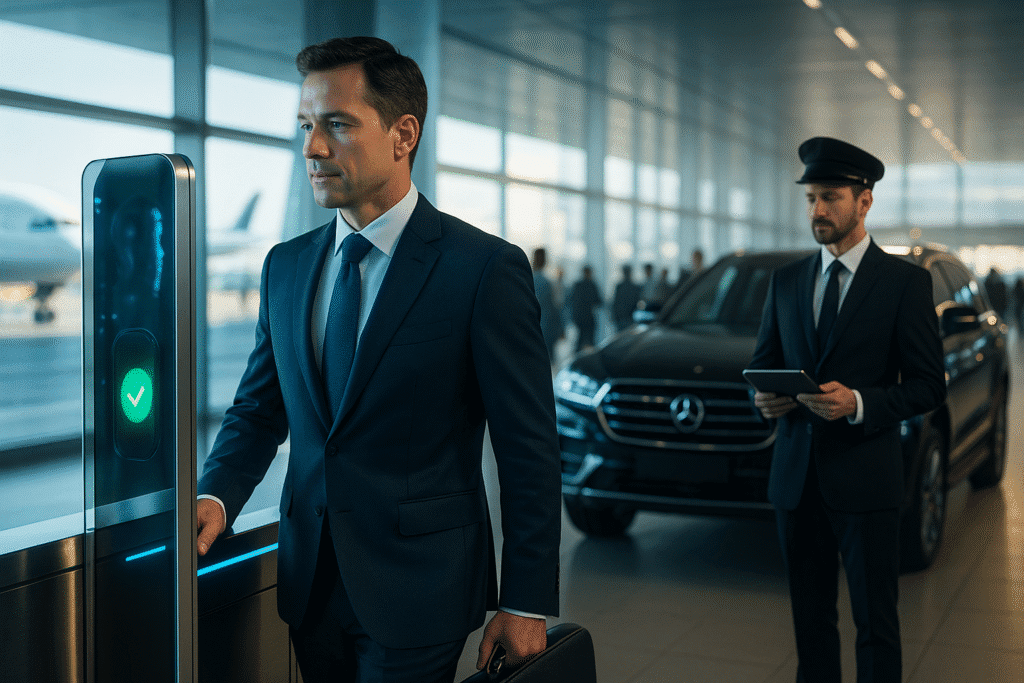Imagine stepping off a 12-hour flight, bleary-eyed, struggling with your carry-on and a half-dead phone. You’re bracing for the usual airport chaos queues, misplaced drivers, and that awkward moment when you can’t find your name on a sign.
Now picture this instead: You walk through the gate, and a camera subtly scans your face; boom, your biometric chauffeur service is ready. A sleek car waits, your driver knows your name, and you’re whisked away without a single form or fumble. Welcome to the future of VIP chauffeur services, where biometric tech is rewriting the rules of luxury travel.
When Did Airport Transfers Get This Cool?
Airport transfers haven’t always been glamorous. Remember the days of hailing a cab, hoping the driver knew the city better than you did? Even VIP chauffeur services used to mean a guy in a suit holding a whiteboard with your name misspelled. However, biometrics, such as facial recognition, fingerprint scanning, and iris detection, have emerged, transforming clunky pickups into something out of a science fiction film. It’s not just tech for tech’s sake; it’s about making high-end travel faster, safer, and, frankly, a lot more impressive.
The Magic of Biometric Chauffeur Service
So, how does a biometric chauffeur service work? It’s simpler than you’d think. Before your flight, you upload your biometric data, such as a selfie or fingerprint, through a secure app. When you land, cameras or scanners at the airport match you to your profile in seconds. No ID checks, no awkward small talk. Your driver gets a ping, your car pulls up, and you’re off. The tech behind it? Facial recognition airport transfers lead the pack, but iris scans and fingerprints are catching up.
Why does this matter? Speed, for one. High-profile travelers, executives, celebrities, or anyone who values their time doesn’t want to waste 20 minutes verifying their identity. Security’s another big win. Biometrics are tougher to fake than a paper boarding pass. And let’s not forget personalization. Your driver already knows you prefer jazz over talk radio and sparkling water over still water. It’s like the universe anticipated your needs and nailed it.
Facial Recognition Airport Transfers: No More Waiting
Here’s the kicker. Facial recognition airport transfers are revolutionizing the old-school check-in process. No more digging for your passport or squinting at a driver’s sign. Airports like Singapore’s Changi and Dubai International are already rolling out facial recognition for everything from boarding to baggage claim. Luxury transport companies, such as Blacklane and Wheely, are jumping on board, syncing biometric data with their apps to match passengers with drivers in real-time.
Take Emirates’ first-class service in Dubai. They’ve piloted a system where your face is your ticket literally. Step off the plane, walk through a biometric gate, and your chauffeur’s already there, door open, no questions asked. Worried about data privacy? These systems use encrypted, anonymized data, and companies like Idemia are setting the gold standard for secure storage. It’s not foolproof, nothing is, but it’s a far cry from handing your ID to a stranger.
Why Contactless VIP Transport is the New Normal
The pandemic changed how we think about travel. Touching keypads, signing receipts, passing IDs back and forth? No thanks. Enter contactless VIP transport, the lovechild of biometrics and post-COVID caution. With this tech, your car is dispatched the moment your face is recognized. Payment? Handled automatically through your app. Preferences? Your seat’s already adjusted, the AC’s set to your ideal 72°F, and your favorite playlist is cued up.
For business travelers, this is a godsend. Time is money, and contactless VIP transport shaves off precious minutes. Imagine a CEO landing in New York, breezing through JFK, and hopping into a car that’s ready before they’ve even checked their email. It’s not just convenience, it’s a competitive edge. Companies like Carey International are investing heavily in this, with touchless systems now standard in their premium fleets.
Next-Gen Airport Pickup: Seamless, Start to Finish
Let’s break down a next-gen airport pickup. You book through an app, say, one from a luxury provider like Sixt. You verify your identity with a quick selfie or fingerprint. The app tracks your flight in real time, so if your plane’s delayed (because, of course, it is), your driver’s still there, perfectly timed. Upon landing, a biometric scanner scans your identification at the gate. Your driver gets an alert, pulls up, and greets you by name. No paperwork, no waiting, no stress.
Compare that to the old way: circling the arrivals hall, dodging pushy cab drivers, praying your chauffeur hasn’t given up and left. Traditional services aren’t bad, they’re just slower. A 2023 study by ACI World found that biometric systems cut airport processing times by up to 30%. For VIP chauffeur services, that’s the difference between good and great.
Smart Executive Travel: Where AI Meets Biometrics

Now, let’s get fancy. Smart executive travel isn’t just about getting from A to B; it’s about crafting an experience. Biometrics is the key, but AI and IoT (Internet of Things) are the secret sauce. Picture this: Your car’s AI predicts traffic patterns, shaving 10 minutes off your commute. The IoT adjusts the cabin’s lighting to match your mood (because jet lag is a real thing). Your driver, synced with your biometric profile, knows you hate small talk and keeps it brief.
Rolls-Royce and Mercedes-Benz are already embedding IoT in their luxury fleets. Climate control, entertainment, even seat massage settings, all tailored to you before you buckle up. It’s like your car reads your mind. A 2024 report by McKinsey predicts that 60% of premium vehicles will have IoT integration by 2030. Add biometrics, and smart executive travel feels less like a ride and more like a personal concierge.
The Catch: Privacy, Glitches, and Growing Pains
Nothing’s perfect, not even biometrics. Privacy is the big one. Handing over your face or fingerprints may feel like a significant request, especially when data breaches are a front-page news story. Companies counter this with encryption and opt-in consent, but skepticism lingers. Then there’s the tech itself. A glitchy scanner or a bad camera angle could leave you stranded. Backup systems, such as manual ID checks, are a must, but they’re not foolproof either.
Traditional chauffeur companies face another hurdle: adoption. Retrofitting biometric tech isn’t cheap, and smaller firms might balk at the cost. But here’s my take: adapt or get left behind. The luxury market thrives on innovation, and clients won’t wait for laggards.
What’s Next? The Sky’s the Limit
Biometrics isn’t done evolving. Voice recognition is creeping in, imagine your car responding to “Take me to the hotel” without a button press. Gait analysis (yes, the way you walk) could identify you from a distance. Emotion detection might even adjust your car’s vibe based on your mood. Sounds wild, right? It’s closer than you think.
Beyond VIPs, biometrics could democratize the travel experience. Budget airlines and mass-market providers, such as Uber, are already exploring the use of facial recognition technology in mainstream airport transfers. By 2035, expect biometric gates at every major airport, with next-gen airport pickup as standard as Wi-Fi is now. The future isn’t just for the elite; it’s for everyone.
Buckle Up for the Future
Biometric tech is no longer a trick; it’s the backbone of VIP chauffeur services. From facial recognition airport transfers to contactless VIP transport, it’s making travel faster, safer, and downright luxurious. Smart executive travel is here, blending AI, IoT, and biometrics into an experience that feels like magic. Although there are hurdles, including privacy concerns and technical glitches, the payoff is worth it.
Ready to ditch the airport hassle? Book your biometric chauffeur service today and step into the future of travel. Trust me, you won’t look back.

